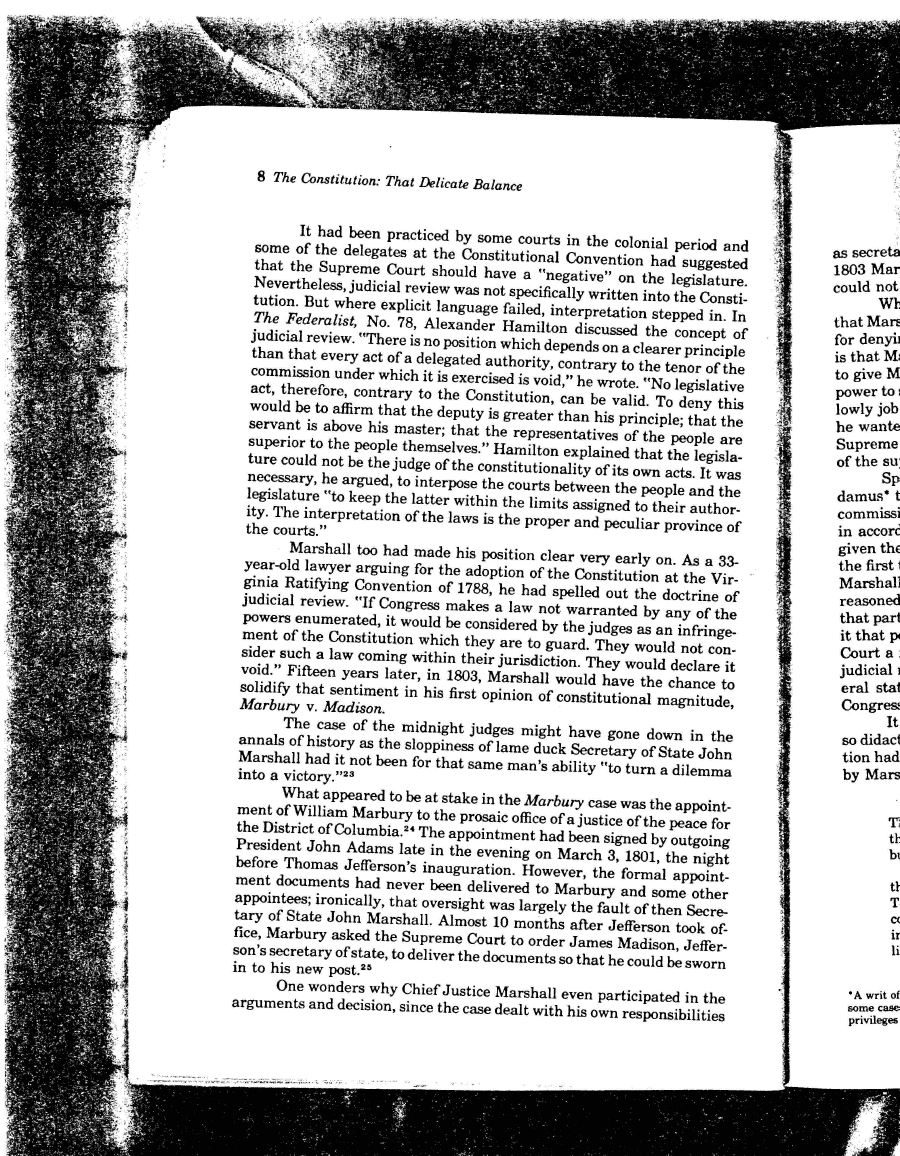|
8 The Constitution: That Delicate Balance
It had been practiced by some courts in the colonial period and
some of the delegates at the Constitutional Convention had suggested
that the Supreme Court should have a "negative" on the legislature.
Nevertheless, judicial review was not specifically written into the Consti-
tution. But where explicit language failed, interpretation stepped in. In
The Federalist, No. 78, Alexander Hamilton discussed the concept of
judicial review. "There is no position which depends on a clearer principle
than that every act of a delegated authority, contrary to the tenor of the
commission under which it is exercised is void," he wrote. "No legislative
act, therefore, contrary to the Constitution, can be valid. To deny this
would be to affirm that the deputy is greater than his principle; that the
servant is above his master; that the representatives of the people are
superior to the people themselves." Hamilton explained that the legisla-
ture could not be the judge of the constitutionality of its own acts. It was
necessary, he argued, to interpose the courts between the people and the
legislature "to keep the latter within the limits assigned to their author-
ity. The interpretation of the laws is the proper and peculiar province of
the courts."
Marshall too had made his position clear very early on. As a 33-
year-old lawyer arguing for the adoption of the Constitution at the Vir-
ginia Ratifying Convention of 1788, he had spelled out the doctrine of
judicial review. "If Congress makes a law not warranted by any of the
powers enumerated, it would be considered by the judges as an infringe-
ment of the Constitution which they are to guard. They would not con-
sider such a law coming within their jurisdiction. They would declare it
void." Fifteen years later, in 1803, Marshall would have the chance to
solidify that sentiment in his first opinion of constitutional magnitude,
Marbury v. Madison.
The case of the midnight judges might have gone down in the
annals of history as the sloppiness of lame duck Secretary of State John
Marshall had it not been for that same man's ability "to turn a dilemma
into a victory."23
What appeared to be at stake in the Marbury case was the appoint-
ment of William Marbury to the prosaic office of a justice of the peace for
the District of Columbia.24 The appointment had been signed by outgoing
President John Adams late in the evening on March 3, 1801, the night
before Thomas Jefferson's inauguration. However, the formal appoint-
ment documents had never been delivered to Marbury and some other
appointees; ironically, that oversight was largely the fault of then Secre-
tary of State John Marshall. Almost 10 months after Jefferson took of-
fice, Marbury asked the Supreme Court to order James Madison, Jeffer-
son's secretary of state, to deliver the documents so that he could be sworn
in to his new post.25
One wonders why Chief Justice Marshall even participated in the
arguments and decision, since the case dealt with his own responsibilities
|

